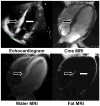Myocardial fat overgrowth in Proteus syndrome
- PMID: 25377688
- PMCID: PMC4275354
- DOI: 10.1002/ajmg.a.36773
Myocardial fat overgrowth in Proteus syndrome
Abstract
Proteus syndrome (PS) is a rare, mosaic disorder with asymmetric and distorting overgrowth of the skeletal system, skin, and adipose tissues. Cardiac abnormalities are rare in this syndrome and only two prior cases have been reported. Many patients with PS followed at our institution underwent transthoracic echocardiograms for preoperative evaluation or as work-up for associated pulmonary disease. Some were noted to have prominent, focal echodense areas in the myocardium. We further investigated cardiac findings in a cohort of children and adult patients with PS. Patients with abnormal echocardiograms were referred for cardiac magnetic resonance imaging, Holter monitoring, and exercise treadmill testing. Twenty children and adults with PS, age 24 months to 50 years old, underwent transthoracic echocardiograms. Seven patients (35%) had focal bright echodense areas within the myocardium suggesting fatty infiltration. The majority of patients had significant involvement of the interventricular septum. The cardiac characteristics of all patients with fatty infiltration on transthoracic echocardiograms were compared to Proteus patients without these findings. There were no significant differences in chamber sizes, mass, systolic or diastolic function. No increased risk of conduction defects or arrhythmias was found. This study shows that abnormal fat overgrowth is a common finding in the myocardium in patients with Proteus syndrome; however, it is not associated with functional derangements or arrhythmias. Further evaluation of a larger number of Proteus patients is needed in order to determine the frequency and prognosis of cardiac involvement. Published 2014. This article is a U.S. Government work and is in the public domain in the USA.
Keywords: cardiac; interventricular septum; myocardial fatty infiltration; proteus syndrome.
Published 2014. This article is a U.S. Government work and is in the public domain in the USA.
References
-
- Adriaensen ME, Schaefer-Prokop CM, Duyndam DA, Zonnenberg BA, Prokop M. Fatty foci in the myocardium in patients with tuberous sclerosis complex: common finding at CT. Radiology. 2009;253:359–363. - PubMed
-
- Baroldi G, Silver MD, De Maria R, Parodi O, Pellegrini A. Lipomatous metaplasia in left ventricular scar. Can J Cardiol. 1997;13:65–71. - PubMed
-
- Biesecker L. The challenges of Proteus syndrome: diagnosis and management. Eur J Hum Genet. 2006;14:1151–1157. - PubMed
-
- Biesecker LG, Happle R, Mulliken JB, Weksberg R, Graham JM, Jr, Viljoen DL, Cohen MM., Jr Proteus syndrome: diagnostic criteria, differential diagnosis, and patient evaluation. Am J Med Genet. 1999;84:389–395. - PubMed
-
- Biesecker LG, Peters KF, Darling TN, Choyke P, Hill S, Schimke N, Cunningham M, Meltzer P, Cohen MM., Jr Clinical differentiation between Proteus syndrome and hemihyperplasia: description of a distinct form of hemihyperplasia. Am J Med Genet. 1998;79:311–318. - PubMed
Publication types
MeSH terms
Grants and funding
LinkOut - more resources
Full Text Sources
Other Literature Sources


